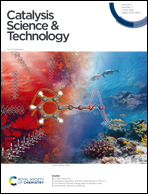Cycloaddition mechanisms of CO2 and epoxide catalyzed by salophen – an organocatalyst free from metals and halides†
Abstract
The cycloaddition mechanisms of CO2 and epichlorohydrin catalyzed by salophen as an organocatalyst were investigated using B3LYP density functional theory computations. The kinetically most favored neutral pathway involves a concerted and synergistic mechanism of phenolate as a nucleophile and phenol as a H-bonding donor in epoxide ring opening and CO2 addition. The computed apparent barrier (33 kcal mol−1) is in line with the reaction conditions (120 °C and 10 bar CO2). A similar and anionic route with a much lower apparent barrier (17 kcal mol−1) to react under milder conditions has been proposed and this has to be proven experimentally.



 Please wait while we load your content...
Please wait while we load your content...